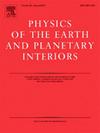热导率对地核顶部稳定区域同时形成和40亿年磁场产生的影响
IF 1.9
3区 地球科学
Q2 GEOCHEMISTRY & GEOPHYSICS
引用次数: 0
摘要
考虑到地核导热系数的不确定性和现今穿过地核-地幔边界(CMB)的热流,评估了在地球外核最上层出现具有长期磁场产生的分层区域的可能性。利用一维热化学模型计算了地球外核的径向结构的各种导热系数和CMB热流值。结果表明,存在既能产生稳定分层又能长期产生磁场的解,尽管其分层区厚度小于100 km。为了满足分层区域的出现和长期磁场的产生,现今CMB热流(13-15 TW)的可能值表明CMB的热导率为77-121 W/m/K,这与地核条件下的电导率测量值吻合较好。在这种情况下,层状区厚度约为50 km,这也与地磁长期变化估计的层状区厚度一致。然而,当当前的CMB热流小于本研究中使用的约束条件时,该分析获得的热导率建议值可能会更小。本文章由计算机程序翻译,如有差异,请以英文原文为准。

Effect of thermal conductivity on the simultaneous formation of a stable region at the top of earth's core and magnetic field generation over four billion years
The possibility of the emergence of a stratified region in the uppermost part of the Earth's outer core with long-term magnetic field generation is assessed, taking into account uncertainties in the thermal conductivity of the Earth's core and the present-day heat flow across the core-mantle boundary (CMB). The radial structures of the Earth's outer core are calculated for various values of thermal conductivity and CMB heat flow using a one-dimensional thermo-chemical model. The results show that there exist solutions that allow both emergence of stable stratification and long-term magnetic field generation although their thickness of stratified region is thinner than 100 km. In order to satisfy both emergence of stratified region and long-term magnetic field generation, possible value of the present-day CMB heat flow (13–15 TW) suggests a thermal conductivity of 77–121 W/m/K at CMB, which is in good agreement with the values estimated from the electrical conductivity measurements under the Earth's core condition. The thickness of the stratified region in this case is about 50 km, which is also consistent with the thickness of the stratified region estimated from the geomagnetic secular variation. However, the proposed values of thermal conductivity obtained by this analysis could be smaller when the present-day CMB heat flow becomes smaller than the constraint used in this study.
求助全文
通过发布文献求助,成功后即可免费获取论文全文。
去求助
来源期刊

Physics of the Earth and Planetary Interiors
地学天文-地球化学与地球物理
CiteScore
5.00
自引率
4.30%
发文量
78
审稿时长
18.5 weeks
期刊介绍:
Launched in 1968 to fill the need for an international journal in the field of planetary physics, geodesy and geophysics, Physics of the Earth and Planetary Interiors has now grown to become important reading matter for all geophysicists. It is the only journal to be entirely devoted to the physical and chemical processes of planetary interiors.
Original research papers, review articles, short communications and book reviews are all published on a regular basis; and from time to time special issues of the journal are devoted to the publication of the proceedings of symposia and congresses which the editors feel will be of particular interest to the reader.
 求助内容:
求助内容: 应助结果提醒方式:
应助结果提醒方式:


